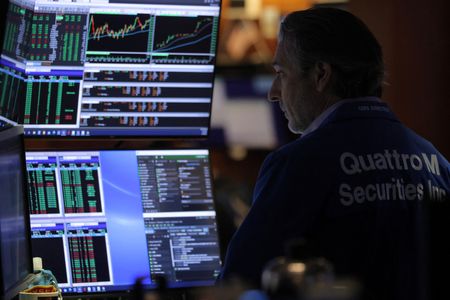
By Amruta Khandekar and Noel Randewich
(Reuters) – The S&P 500 tumbled on Friday, putting the widely followed benchmark on the verge of confirming it has been in a bear market since hitting a record high in January.
Worries about surging inflation and rising interest rates have pummeled the U.S. stock market this year, with danger signals from Walmart Inc and other retailers this week adding to fears about the economy.
Wall Street opened stronger on Friday morning before turning sharply negative and adding to deep losses sustained earlier in the week.
“Any positivity is being sold in a very heavy and high-volume fashion, and that’s very concerning,” said Keith Buchanan, a portfolio manager at Globalt Investments. “It feels like it’s fear driven.”
The S&P 500 was on track to close down 19.4% from its Jan. 3 record high close. Closing down 20% from that record level would confirm it has been in a bear market since reaching that high, according to a common definition. That would be the S&P 500’s second bear market since the 2020 global selloff caused by the coronavirus pandemic.
Earlier in Friday’s session, the S&P 500 was down almost 21% from its January high.
The tech-heavy Nasdaq was last down 29% from its record close in November 2021.
Graphic: S&P 500 bear markets – https://fingfx.thomsonreuters.com/gfx/mkt/klpykodqmpg/Pasted%20image%201653065756392.png
Weighing heavily on the S&P 500, Tesla dropped 9.8% after Chief Executive Elon Musk denounced as “utterly untrue” claims in a news report that he sexually harassed a flight attendant on a private jet in 2016.
Other megacap stocks also fell, with Apple down 2.7% and Google-owner Alphabet Inc losing 3.7%.
Ten of the 11 major S&P sectors declined, with consumer discretionary and industrials down 3.5% and 2.4%, respectively.
Shares of Deere & Co tumbled about 14% after the heavy equipment maker posted downbeat quarterly revenue.
Recent disappointing forecasts from big retailers Walmart, Kohl’s Corp and Target Inc have rattled market sentiment, adding to evidence that rising prices have started to hurt the purchasing power of U.S. consumers.
On Friday, Ross Stores plunged over 20% after the discount apparel retailer cut its 2022 forecasts for sales and profit, while Vans brand owner VF Corp gained 3.9% on strong 2023 revenue outlook.
The S&P 500 and the Nasdaq are set for their seventh straight week of losses, their longest losing streak since the end of the dotcom bubble in 2001.
The Dow is on track for its eighth consecutive weekly decline, its longest since 1932 during the Great Depression.
Traders are pricing in 50-basis point rate hikes by the U.S. central bank in June and July.
In afternoon trading, the S&P 500 was down 1.97% at 3,823.92 points.
The Nasdaq declined 2.61% to 11,091.22 points, while the Dow Jones Industrial Average was down 1.72% at 30,714.43 points.
Graphic: S&P 500’s busiest trades – https://fingfx.thomsonreuters.com/gfx/mkt/gdpzyedkzvw/SPX_by_busiest_trades.png
Expiration of monthly options contracts on Friday was likely to boost trading volumes and could also add to volatility, especially toward the end of the session.
About two thirds of S&P 500 stocks are down 20% or more from their 52-week highs.
Declining issues outnumbered advancing ones on the NYSE by a 3.00-to-1 ratio; on Nasdaq, a 2.61-to-1 ratio favored decliners.
The S&P 500 posted 1 new 52-week highs and 48 new lows; the Nasdaq Composite recorded 10 new highs and 325 new lows.
(Reporting by Amruta Khandekar and Devik Jain in Bengaluru, and by Noel Randewich in Oakland, Calif.; Editing by Shounak Dasgupta, Arun Koyyur and Grant McCool)

